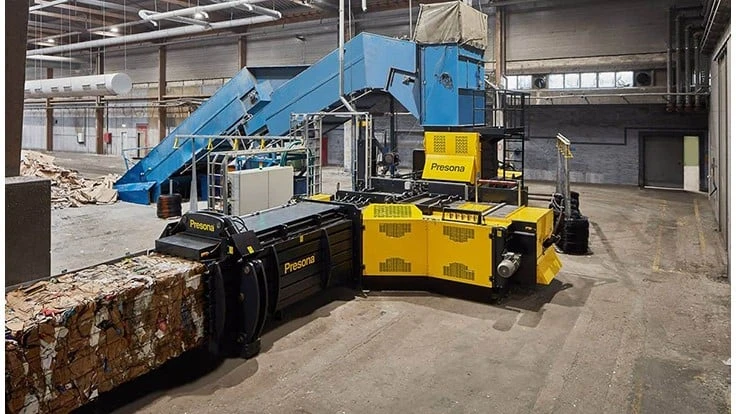
Image courtesy of Presona AB.
The COVID-19 pandemic caused numerous adjustments to how people work, study and interact socially. Among those trends was a greater reliance on home deliveries (most often in cardboard boxes) and a heavier reliance on retail groceries—a sector that receives its merchandise most commonly in boxes made of containerboard.
Thanks to commercial recycling programs and the work of community recycling programs and material recovery facility (MRF) operators who collect and bale old corrugated containers (OCC) from the residential stream, the boxes enjoy a high recycling rate.
The vast majority of this collected OCC has a date with a baler in the course of its recycling journey. As recycling companies and programs grow in scale (as does OCC volume), it has prompted baler manufacturers to design and make balers that can handle the steady stream of discarded boxes.
Sweden-based Presona offers one example with its MP 270 MH baler, introduced last year. Presona says the baler has been designed to reduce recycling costs while increasing operational efficiency. The firm touts what it calls “a revolutionary new design concept that creates super-high capacity while being very cost-effective. This means that a single MP 270 MH baler can replace several smaller balers at a significantly lower cost.”
The new baler also is referred to as Presona’s Mega model, and the firm says it “is intended for recycling and sorting plants or other businesses that bale large quantities of material.” Presona says the MP 270 MH “has a real capacity of 45 metric tons (49.6 short tons) of material per hour.” The firm says that’s 50 percent more than Presona’s second-largest baler, the LP 140, and three times as much as the smaller LP 60.
The Swedish firm is far from alone in offering large volume balers for OCC and other materials being baled in large volumes to meet the world’s growing recycling rates.
In August 2020, Canada-based Machinex reported having sold and installed 12 two-ram high-capacity balers in Canada and the United States during the previous 12 months.
“One of our clients in St. Louis considered four other major two-ram baler manufacturers as a part of their buying process,” said the company’s Rusty Angel. “They selected the Machinex baler because we had the lowest ‘cost of ownership’ over a 10-year period when considering baling capacity and annual maintenance.”
Netherlands-made Bollegraaf balers have been sold in North America by Van Dyk Recycling Solutions, Norwalk, Connecticut, for several decades. In a custom publishing piece prepared for Van Dyk last year, two of its customers credited the considerable capacity of their Bollegraaf units as one of the baler’s strong points.
“We’re a one-baler facility with a smaller footprint,” said Scott Jenkins of Oregon-based EFI Recycling. “We can’t increase our footprint, but we can increase our speed and capacity. With the [Bollegraaf] HBC140, we can run the same tonnage as a facility twice our size. Right off the bat, it added 25 percent to our capacity with no signs of slowing down. Most of the time, we can’t feed it fast enough.”
Brian Dubis, a MRF operations manager at Rhode Island Resource Recovery Corp., said, “We have an HBC120 for containers and an HBC140 for fiber. Both exceed our expectations of throughput and uptime for our 50-ton per hour system.”
In 2018, Florida-based International Baler Corp. (IBC) began making its ATX auto-tie baler series, which it describes as a high-volume, “European style” baler for MRF and municipal solid waste (MSW) applications.
Designed for high-production applications, the ATX auto-tie baler is ideal for single- and dual-stream recycling facilities, large fiber processors and municipalities where speed is a necessity, according to IBC. The ATX is capable of processing more than 60,000 cubic feet of material per hour, with throughputs of up to 50 tons per hour.
Among balers offered by Georgia-based Harris, its Conquest line “dramatically increase production while virtually eliminating bridging problems,” according to the company. Harris says the Conquest 180 model can bale up to 45 tons per hour of OCC and from 60 to 90 tons per hour of old newspapers (ONP) and high grades of fiber.
The recovered fiber to feed these large balers seems unlikely to diminish. In the United States, according to the American Forest & Paper Association (AF&PA), the OCC recycling rate remained close to 90 percent in 2020 despite some difficulties in collection when COVID-19 was rampant and distancing restrictions were widespread.
In its summary of U.S. paper recycling activity in 2020, AF&PA says recycled paper use at U.S. pulp and paper mills rose by about 286,000 tons, and U.S. mill consumption of OCC reached a record high of 22.8 million tons.
AF&PA President and CEO Heidi Brock says, “Our industry leadership remains strong with $4.1 billion in manufacturing infrastructure investments, announced, planned or made, from 2019 to 2023, to continue the best use of recycled fiber in our products.”
Latest from Recycling Today
- BMW Group, Encory launch 'direct recycling’ of batteries
- Loom Carbon, RTI International partner to scale textile recycling technology
- Goodwill Industries of West Michigan, American Glass Mosaics partner to divert glass from landfill
- CARI forms federal advocacy partnership
- Monthly packaging papers shipments down in November
- STEEL Act aims to enhance trade enforcement to prevent dumping of steel in the US
- San Francisco schools introduce compostable lunch trays
- Aduro graduates from Shell GameChanger program





